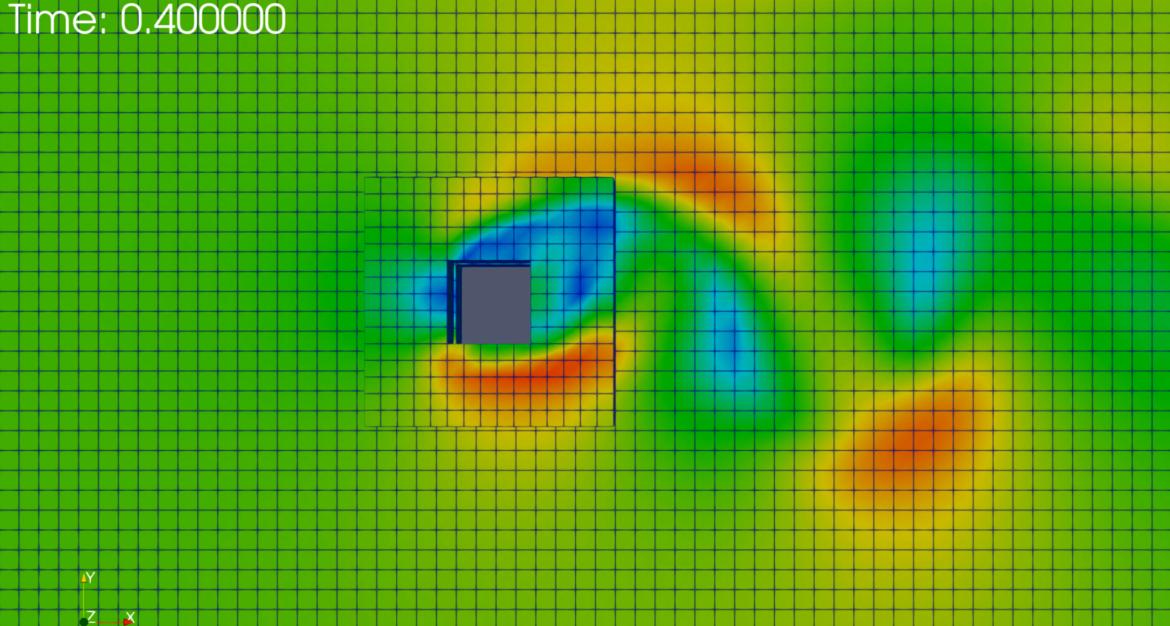We have covered various dynamic mesh techniques using mesh deformation (or mesh morphing) in the previous articles. In this article, we will provide a brief introduction to overset mesh and its application in OpenFOAM, including the advantages of overset mesh and the theory behind it.
OpenFOAM provides overset mesh capabilities since OpenFOAM-v1706. In this article, we will be providing the overview of overset mesh in OpenFOAM, enabling you to understand the concepts behind the overset mesh and create your own simulation using overset mesh in OpenFOAM.
Overset meshes or Chimera meshes have been regarded as one of the most advanced CFD techniques. The most appealing thing about overset meshes is that these meshes can enable several various mesh motion types almost impossible for other mesh motion techniques.
Overset meshes have two main advantages over other types of meshes.
- Handling complex motion of bodies
- Simplified mesh generation
Handling complex motion of bodies
Overset meshes allow overlapping grids that can move relative to each other. Each mesh can be generated and moved independently, allowing very complex mesh motions of automobile, aircraft and ships as well as turbo machinery and marine propellers. For example, the interaction between ship hull, rudder and propeller during sea keeping simulations is a very complex coupled motion system which is impossible to model when using other mesh motion techniques such as mesh deformation or sliding meshes. Mesh deformation approaches cannot be used for problems involving severe body motions such as large translational motion amplitudes or rotational motions coupled by translations. Overset mesh can enable such a difficult body motion due to its nature of allowing multiple meshes overlapping on each other. Other examples may be separation of space shuttle from rockets.
Simplified mesh generation
Different parts of the geometry can be separately meshed when using overset mesh.The ability to generate mesh for each body makes the mesh generation process easier for bodies of complex shapes. Especially if structured meshes are used, being able to separately mesh each body reduces the struggle of having to generate several blocks between each body. Therefore, several high fidelity finite difference solvers used in aerospace industry employ overset grids since block structured meshes are the most common mesh types for finite difference solvers.
How overset mesh works
Overset mesh applies interpolation between background and overset cellzones. To model the walls inside the background mesh, some of the background cells are blocked off and these are called holes. Fundamentally, overset meshes employ these following cell/zone types.
- Donor cells : cells that provide values
- Acceptor cells : these are the cells whose value gets set from interpolation
- Hole cells : unreachable/inactive cells
- Mesh zone : indicator field to denote potentially overlapping mesh regions
- Overset patches : patch type next to cells that are to be interpolated
The mapping between background and foreground mesh determines which parts of the mesh are:
- solved, calculated (blue region);
- interpolated from solution cells, interpolated (white region); and
- not used, holes (red region).
The process of identifying and masking the hole regions is known as “hole cutting.” This process is typically automated using algorithms that identify which cells are inside or near solid boundaries and which are covered by other grids. The details of these methods and algorithms can be found in this OpenFOAM Wiki page.
Applications
Overset meshes are widely used in applications such as:
- Aerodynamics: Aircraft with moving control surfaces, rotating propellers, or flapping wings.
- Automotive: Simulating moving parts within engines or under different operating conditions.
- Marine: Interaction of ships with water, including moving components like propellers.
Conclusion
The overset mesh technique provides a robust framework for simulating fluid flow around complex, moving geometries. By using multiple overlapping grids and efficient interpolation methods, it overcomes many limitations of traditional single-grid approaches, enabling more accurate and flexible CFD simulations.


